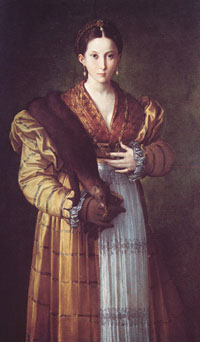
Conceived as a country house, the Royal Palace of Capodimonte assumed the stature of a Royal Palace, enriched by a magnificent park, whose avenues were designed by the great Neapolitan architect Sanfelice. When Charles inherited the marvellous Farnese collection from his mother, Elisabeth Farnese, he wanted to place it in the new palace. Built in 1816, a great part of the collection was transferred to the National Museum, where the paintings, bronzes and Pompeii statues stood. Now the collection has been restored to its original home, so leaving more space for the archeological collection of the National Museum. After the last war, the future of the great Royal Palace, immersed with its red-grey immensity in the XVIII century park, seemed uncertain. No one had lived in it since the accession of the House of Savoy, when it had been assigned to the house of Aosta. The idea of installing the Aeronautic Academy was proposed, and it was suggested breaking up the park and disfiguring the monumental building of great importance. The Superintendent of Works of Art for Campania, Bruno Molajoli, conducted a lively campaign to use the palace as a museum, making it an art gallery worthy of Naples, transporting the pictures that crowded the Museum, which for its part needed more space to devote to its own archeological collection. The idea was agreed to and Naples now has one of the most modern museums in Europe set in sumptuous surroundings, with the most functional lighting, heating and restoration facilites. It seems as though we are back in the times of Charles of Bourbon, when the site of Capodimonte seethed with art, and the activities of the porcelain factory, which was in the park itself, made the name of Capodimonte famous. There are hundred rooms, restored and rearranged, as well as the picture gallery. Among the pictures are the monumental Crucifixion by Masaccio, Botticelli’s Madonna with Angels, the famous Gypsy by Correggio, Giambellino’s Transfiguration, Sebastiano del Piombo’s Clement VII, and the wonderful portraits by Parmigianino and Titian. There are also works by Raphael, Pinturicchio, Luca Signorelli, Goya, Perugino, Simone Martini, Colantonio, Bruegel. In addition to the classic paintings there is a copious collection of the XIX century Neapolitan art, with Gigante, Migliaro, Mancini, Michetti and others. Also there are collections of Renaissance armour, ivory, crystal and the famous porcelain salon: a room whose walls are entirely covered in porcelain, with a great chandelier hanging from the ceiling, shattered by bombs and miraculously reconstructed. Today thousand of rare and precious objects present the visitor with a wonderful variety; and when the eye has had its fill of the wonders of art, one has merely to step on to the tufa balconies and breathe the pure air of the Park, and gaze upon the sea in the bay, between the tall trees. The Museum was opened in 1957 and is not yet widely known throughout the world; but those who have visited this surprising and delightful place have realised that, with this achievement, Naples has been able to reaffirm its cultural tradition. The rest of the rooms with their comfortable settees, smoking room, heating and electrical ventilation, modern lifts, bar and panoramic terrace, all go to make the visit to the hundred rooms of the Museum a pleasant one. The Museum’s picture restoration rooms are among the finest in Europe.